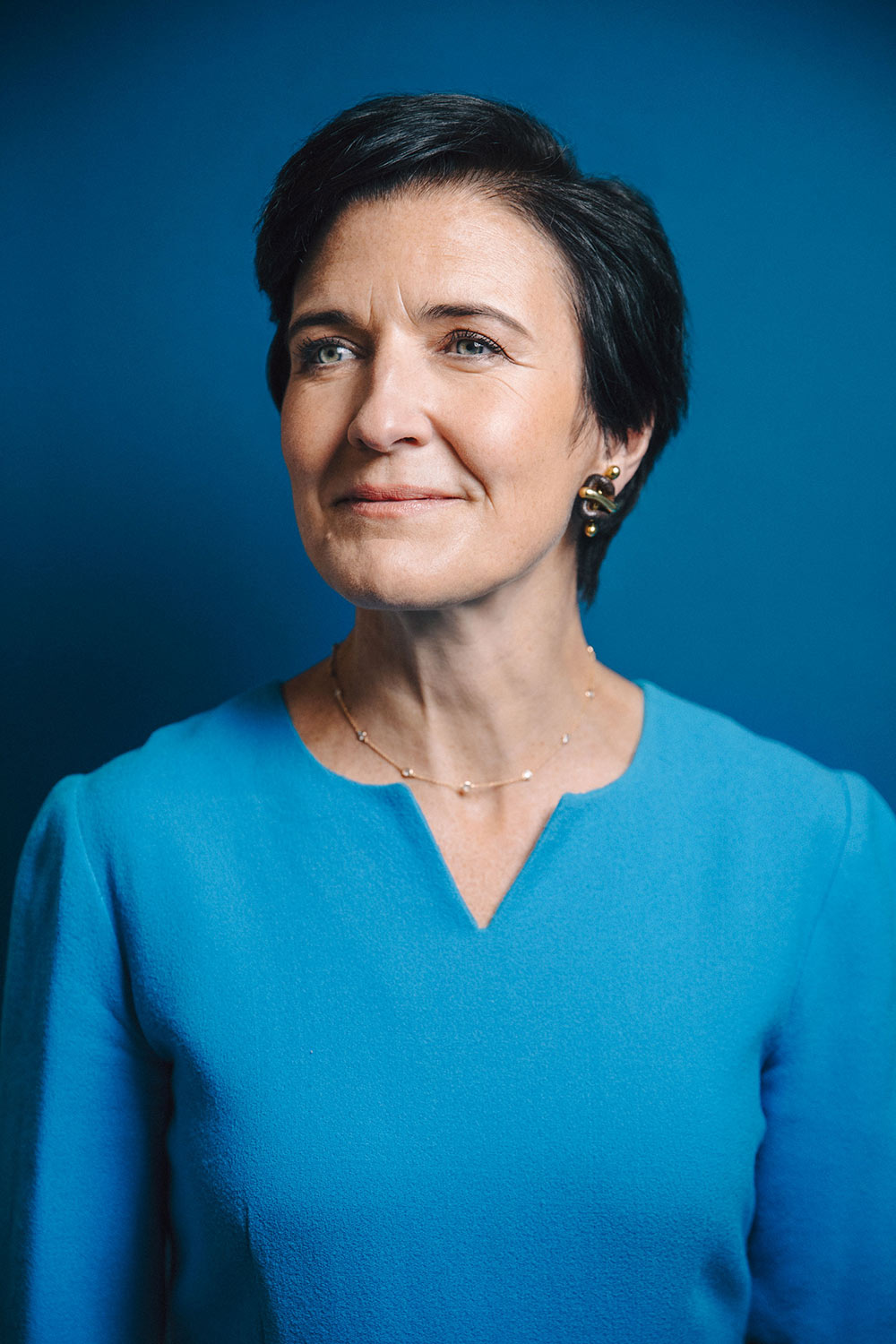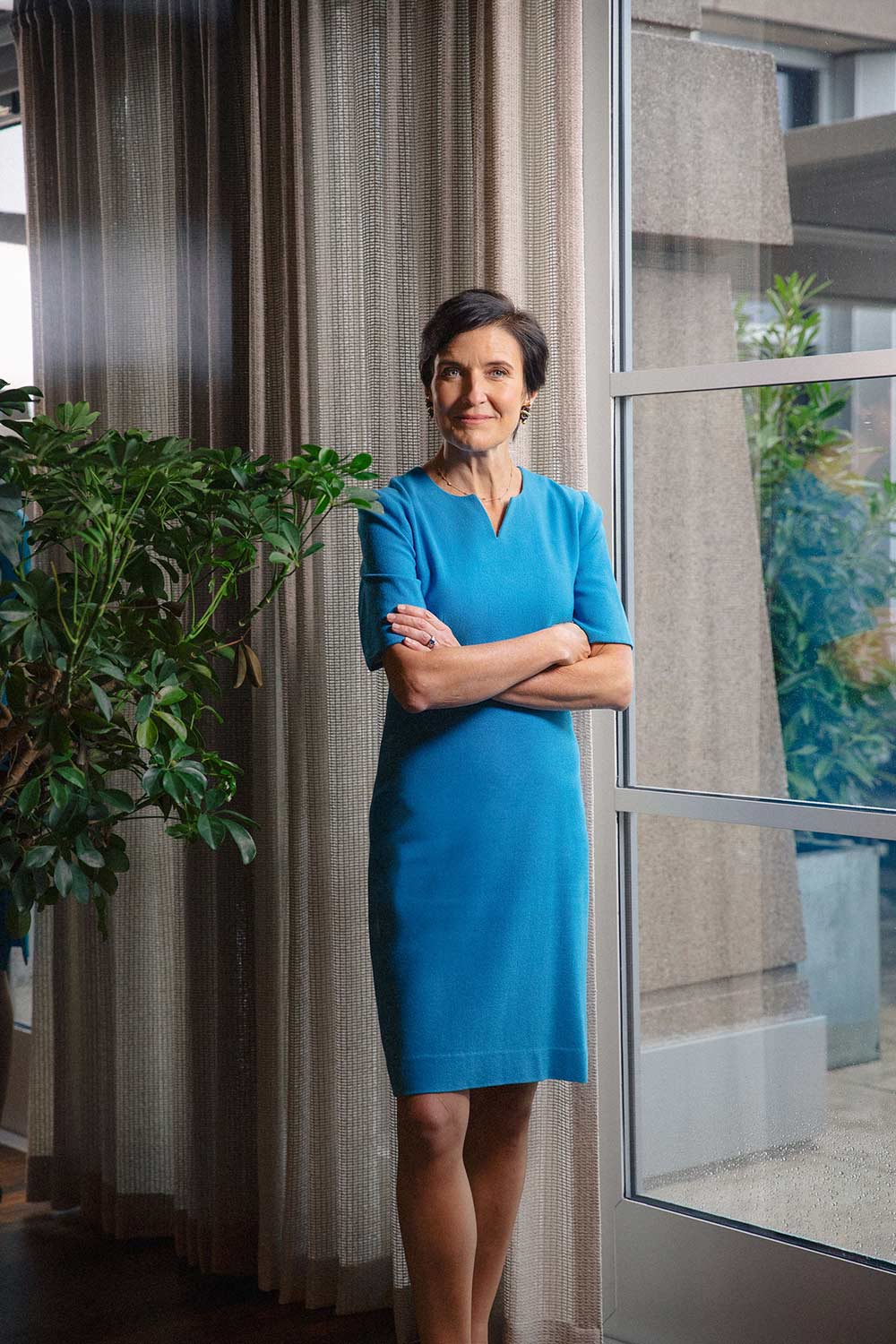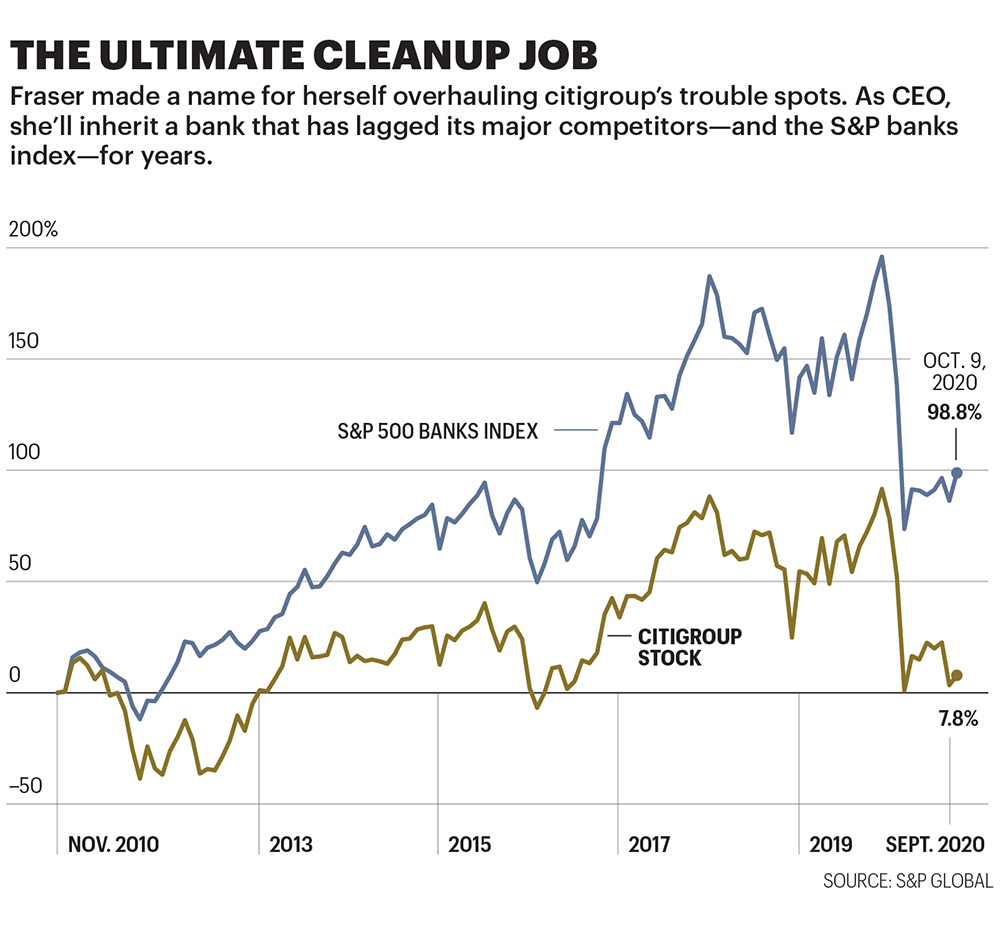华尔街没有女CEO的魔咒,被她打破了

2019年4月,美国七大银行的首席执行官出席了众议院金融服务委员会的会议。在委员会成员宣誓时,在场的清一色全是白人男性,当他们被问到他们的继任者是否可能是女性或有色人种时,没有人举手。
这片沉默凸显了一个铁一般的事实:华尔街从来没有女首席执行官,而且不久的将来也不会有。
然而,这一事实与当时美国企业界的变革情绪背道而驰。
#MeToo运动推动人们重新审视办公室文化。机构投资者开始要求董事会增加女性,包括银行在内的各种公司都在宣扬多元化。
然而开头的那一幕实在令人失望。
后来,《财富》杂志在2019年《全球最具影响力的商界女性》专刊中特地留出数页,提出了三个紧迫的问题:为什么银行首席执行官这一职位对女性来说仍然如此难以触及?谁可能成为第一个突破者?而这一突破何时才会来临?
对于后面两个问题,现在有了明确的答案:今年9月中旬花旗集团宣布,简·弗雷泽(Jane Fraser)将于明年2月接替高沛德(Michael Corbat)出任首席执行官。
除非出现不可预知的变故,长期以来华尔街银行的隐形天花板已经成为历史。
但弗雷泽的任命并未彻底消除多年来女性无缘出任高层领导的文化。
这又引发了一系列新问题:首位出任华尔街大型银行首席执行官的女性是谁?她如何实现这一看起来似乎无法实现的目标的?
一方面,弗雷泽职业生涯的最新一步非常符合简·史蒂芬森所说的“成功路线图”,史蒂芬森是高管猎头公司光辉国际里首席执行官接任部门的负责人。
具体来说,她在花旗各个关键业务部门都工作过,每次离任时的业务状况都比她刚接手时好。而与此同时,她拒绝为了追求事业牺牲个人生活,违反了以往很多成功登顶的旧“规则”。
这种如同在古老迷宫中闯新路一般的寻找折中之道的能力,可能正是她格外适合这份工作的关键。
也正因如此,她愿意坦率谈论这份闯出迷宫的经验。
弗雷泽现年53岁,出生于苏格兰圣安德鲁斯,热爱打高尔夫球。
她高中搬到了澳大利亚,最初渴望成为一名医生。但她很快发现自己学不好生物,却格外擅长数学和经济学,于是自然而然向银行业发展。
弗雷泽毕业于剑桥大学,20岁就在伦敦的高盛公司工作。多年后,她感叹自己是办公室里“无聊的英国女孩”。
“其他人来自欧洲各地,更具异国情调。他们年纪稍长,会说多种语言,我觉得他们比我有趣得多。”2016年,她在智库美洲理事会和美洲协会的一次演讲中说道。
这种感觉促使她离开了伦敦,前往马德里,在咨询公司Asesores Bursátiles担任了两年分析师,期间提升了西班牙语能力。多年后这项技能发挥了巨大作用。
上世纪90年代初,她从哈佛商学院毕业后,职业生涯进一步偏离了典型的银行业成长轨迹。
她加入了麦肯锡,同时直言不讳地表达了做出这一选择的原因是,她认为银行业的女性让人“望而生畏”,她在2016年的演讲中表示。
那是一个流行女性戴大垫肩,穿男性化西装的年代。浸泡在银行业的女性和很多男性似乎没有“那么幸福,”她回忆说,“他们确实非常成功,也很聪明。但很艰苦。”
简而言之:她想要正常的生活。
在麦肯锡工作的强度也很大,但同样有催人奋进的动力:成为值得信赖的顾问,尽可能准确地帮客户进行预测。

两年之后,她结婚了,并于有望升级为合伙人的那年怀孕。
“很多人建议我,‘要升合伙人的时候别怀孕。’但我觉得这简直就是胡说八道。”在今年10月《财富》最具影响力的商界女性峰会上,她对我说道。
她生孩子两周后,公司通知她成为了合伙人。
在此之后,她确实听取了另一条建议:“我记得一位导师曾经对我说:‘你一生中会有好几份职业,要从几十年的视角进行衡量。为什么要着急,恨不得一步登天呢?’”
这番话刺激她做出了一个至关重要的决定,在麦肯锡当合伙人的五年全是兼职,并于2004年离开麦肯锡,去了花旗工作。
“做这个决定并不容易,我感到自尊受挫——因为能够看到那些没有自己资深的人职业发展更快。”她说,“但我真正感受到快乐,实现了工作和个人生活的平衡。”
那段经历改变了她职业观,也改变了她在办公室工作的方式。
弗雷泽说:“当我回到工作岗位全职工作时,客户经常告诉我:‘现在的你更有同理心,以前的你只是台机器。’”
2004年,弗雷泽加入花旗,担任伦敦投资和企业银行业务部客户战略主管。此时的她又演回了银行业的剧本,却开始再次不走寻常路。
在接下来16年里,她在花旗担任了一系列的工作,从中学习了不同部门的业务,积攒了领导独立核算部门的经验,也获得了在公司内部建立联系和打造名声的机会。
“看她的背景就知道。”史蒂文森说。弗雷泽的轮岗“是持续积累的10年,这是一个巧妙的过程。”她说。董事会考虑接班人时,“这种工作经历会提升可信度”。
当然,如果其中一些岗位需要做出艰难决策,或需要处理陷入困境的业务,这种经历确实会有所帮助,但前提是要证明自己有能力应对得当。
2007年9月,随着金融危机加剧,时任首席财务官的加里·克里滕登让弗雷泽担任全球战略与并购主管。她在接受这份工作后搬到纽约,协助时任首席执行官的潘伟迪(Vikram Pandit)判断如何收缩银行规模。
她策划了将花旗日本证券业务出售给三井住友金融集团的交易,作价80亿美元。这帮助2009年的花旗获得了亟需的资本金。除此之外,她还为花旗将美邦经纪业务出售给摩根士丹利打好了基础。
任职期间,她在18个月内完成了超过25笔交易。在这一过程中花旗出售了价值近万亿美元的资产,裁员10万人。
弗雷泽回忆称,那段工作是她作为领导者的重要经历之一。
“当你真正能身处其位时,才能切实了解情况,不会流于空泛。”10月她告诉我。
“究竟要怎么做,才可以避免让客户驱动只是停留在墙上的口号?你做了哪些战略决策?及早着手,认真应对,然后逐渐累积优势争取胜利……危机当中的学习曲线最陡峭。”
尽管并购业务的经历很有价值,弗雷泽还是想实际经营企业。
2009年,潘伟迪给了她机会,让她回伦敦工作四年,担任花旗私人银行负责人,为花旗最富裕的客户提供服务。这份工作相当吸引人,尤其是与接下来在圣路易斯担任花旗抵押贷款公司的首席执行官相比。
2013年她接手该工作,而这段经历正如她在2016年演讲中所承认的,当时的抵押贷款业务如同次贷危机后的“地球劫难”。在她执掌下,花旗经历了缓慢而痛苦的恢复过程,主要因为多年前花旗曾经向房利美和房地美出售不良抵押贷款,并为处理索赔支付了数亿美元。
2015年,高沛德任命弗雷泽为花旗拉丁美洲业务首席执行官,她再次获得机会力挽狂澜。
按净收入计算,拉丁美洲在花旗地区分部中规模最小但利润率最高,如同皇冠上的宝石。
花旗在墨西哥的零售部门,当时被称为墨西哥国家银行或Banamex,是墨西哥最大的银行之一,分行达1400家,占花旗全球实体分支机构一半以上。
在弗雷泽接手时,该业务深陷泥潭。
2014年2月,花旗披露称石油服务公司Oceanografía涉嫌从Banamex骗取了4亿美元。几个月后,Banamex发现某个为高管提供安全保障的部门员工向外部提供未经授权的服务,且从事非法活动,因此随后解散了该部门。
2017年,在接受《美国银行家》杂志采访时,弗雷泽谈到要改变花旗在拉丁美洲的文化,不能再让员工“对问题恶化视若不见,而是要主动提出,‘我对老板的做法感到不安。’”
这项工作很重要一步就是让员工相信,举报不当行为之后,银行确实会采取对应行动。
“这很大程度上取决于信任。”她说。人们必须相信“他们提出问题不会惹祸上身,且公司会采取措施处理。”

弗雷泽出任拉美业务首席执行官后,拉美分部还出售了巴西、阿根廷和哥伦比亚等国的消费银行和信用卡业务,更专注于当地机构业务。
与此同时,花旗向墨西哥注入了10亿美元,墨西哥是拉美国家当中唯一仍然有零售业务的国家。
2016年,花旗宣布了为期四年的投资,主要通过升级自动柜员机、提供新型数字工具和分行改造来提升客户体验。
弗雷泽任职期间,拉丁美洲分部的净收入和净利润分别增长了8%和38%。
弗雷泽在这之后一次升职是在2019年10月,出任全球消费者银行总裁兼首席执行官。这也表明她在拉美分公司的工作受到首肯,从而迈上新台阶。
从同事们口中透露出的迹象也可证实,弗雷泽是高沛德的继承人。
“消费业务占收入一半,也是直线经营业务,现在都交给了她,还让她当这块业务的总裁,这就是准备让她当首席执行官。”花旗集团主席约翰·杜根说。
不过花旗正式任命弗雷泽为首席执行官的时间比预期的要快。
弗雷泽被任命为总裁时,高沛德曾经表示他还要在花旗工作“几年”,然而11个月后,公司便宣布二号人物上位。
在领英的一篇帖子中,高沛德自称“坚决支持任期限制”。
杜根说,高沛德一直计划2021年离任,但如今决定将时间提前,以便弗雷泽能够“实际掌控”花旗改善控制和风险流程的进度。
时间表的提前也给了花旗董事会领先优势,使其成为了华尔街首家提名女性首席执行官的大银行。
“我们很高兴能够率先实现突破,也很高兴公司里有极为适合这份工作的候选人。”杜根说。
从很多方面看,弗雷泽强悍的简历与以前大型银行的首席执行官有相似之处,但她对工作的态度却并不一定符合过往领导者的模式。
很多首席执行官都不愿承认自我怀疑的存在,她似乎不怕谈起。
她说,获得担任全球战略与并购主管的第一反应是,凭自己的能力难以胜任。
后来还是一位朋友说服了她:“你为什么担心失败?尽力试试。就算失败又有什么关系?”
弗雷泽愿意谈论工作中人性化的一面,无论是缺乏自信、为人父母的压力,亦或是银行文化过往的失败。她不仅在华尔街同辈中鹤立鸡群,就算与其他在各自行业中“登顶”的女性相比也毫不逊色。
有些女性会担心,如果公开这类想法,会容易被贴上女首席执行官的标签。而弗雷泽则认为这种坦诚是优势:“在某些方面,我可能更容易受到伤害,我的一些男性同事不太愿意谈论这一问题的人性层面。”5月她告诉我,“这不代表软弱或无力,我认为这会使我更强大。”
在被派往拉丁美洲之前,弗雷泽曾接替现已退休的塞西莉亚·斯图尔特担任花旗美国消费者和商业银行首席执行官。领导层交接期间,两人会见了全国各地的银行家。
斯图尔特回忆说,弗雷泽可以“很自然地坐下来和别人交谈,而且不论工作上还是生活上都可以迅速建立联系。”
“不管是男性还是女性,拥有饱含如此同理心的领导风格,能够坦诚地讨论各种情况非常重要。”斯图尔特说。
这种领导风格尤其适合应对疫情。“对美国企业界来说,2021年和2022年可能截然不同。”斯图尔特表示,“因此,花旗能有这样一位灵活,并愿意以开放心态领导公司经历变革的领导人,无论结果怎样,都是好事。”
当然,打破这层隐形天花板只是开始。这位大型银行圈子里的首位女首席执行官所接手的并非是一台运转良好的机器。
花旗任命弗雷泽为首席执行官后不到一个月,美联储和美国货币监理署均指责该行风险控制长期存在缺陷,为此花旗同意支付4亿美元。
而在此前的8月,花旗集团曾经向Revlon lenders误汇了9亿美元,约为正确金额的100倍。
根据货币监理署的指令,监管方面有权否决花旗的重大收购,必要时还可以强制要求花旗高管团队或董事会变更。
监管机构“一般不会如此严厉,除非真被惹怒,”乔治·华盛顿大学的法学教授,曾经研究银行监管的亚瑟·威尔马思表示。
花旗在一份声明中表示,对于未能达到监管机构的预期深表失望,“正实施深层整改”。
投资者也渴望弗雷泽能够解决花旗的盈利能力问题。因为长期以来,花旗一直落后于华尔街的其他竞争对手。

此外,另一大挑战是对花旗的控制。
“当前正面临疫情和经济衰退夹击。贷款损失将上升,利率也处于历史低位。”巴克莱银行的分析师杰森·戈德伯格表示。可以说,现在对银行家来说,是非常艰难的时期。
监管举措对花旗来说是一记重拳,但威尔马思认为,从某种程度上说,这其实巩固了弗雷泽的地位。这种情况下,“如果没有监管者默许,我怀疑她很难顺利晋升。”威尔马思说。(花旗对此拒绝置评。)
戈德伯格说,从弗雷泽的过往经历来看,她确实适合此时上任。花旗“需要一些调整,”他指出,“她在清理业务和扭转局面方面经验丰富。”
弗雷泽在10月的谈话中也对此表示了认同。
面对任何危机,“都要回过头来说:‘出现问题的根本原因是什么,如何将危局变成机会,真正实现跨越式发展,推动银行迈上新台阶?’”弗雷泽说。“如何激励公司朝着正确的方向努力?我在私人银行成功过,在抵押贷款部门成功过,在墨西哥也成功过。现在有机会能带领花旗,我对此感到很兴奋。”
今年9月,弗雷泽成了第一位获得华尔街首席执行官职位的女性。到了明年2月,她将正式成为花旗掌门人。(财富中文网)
本文另一版本登载于《财富》杂志2020年11月刊,标题为《华尔街第一女性》。
译者:夏林
编辑:徐晓彤
2019年4月,美国七大银行的首席执行官出席了众议院金融服务委员会的会议。在委员会成员宣誓时,在场的清一色全是白人男性,当他们被问到他们的继任者是否可能是女性或有色人种时,没有人举手。
这片沉默凸显了一个铁一般的事实:华尔街从来没有女首席执行官,而且不久的将来也不会有。
然而,这一事实与当时美国企业界的变革情绪背道而驰。
#MeToo运动推动人们重新审视办公室文化。机构投资者开始要求董事会增加女性,包括银行在内的各种公司都在宣扬多元化。
然而开头的那一幕实在令人失望。
后来,《财富》杂志在2019年《全球最具影响力的商界女性》专刊中特地留出数页,提出了三个紧迫的问题:为什么银行首席执行官这一职位对女性来说仍然如此难以触及?谁可能成为第一个突破者?而这一突破何时才会来临?
对于后面两个问题,现在有了明确的答案:今年9月中旬花旗集团宣布,简·弗雷泽(Jane Fraser)将于明年2月接替高沛德(Michael Corbat)出任首席执行官。
除非出现不可预知的变故,长期以来华尔街银行的隐形天花板已经成为历史。
但弗雷泽的任命并未彻底消除多年来女性无缘出任高层领导的文化。
这又引发了一系列新问题:首位出任华尔街大型银行首席执行官的女性是谁?她如何实现这一看起来似乎无法实现的目标的?
一方面,弗雷泽职业生涯的最新一步非常符合简·史蒂芬森所说的“成功路线图”,史蒂芬森是高管猎头公司光辉国际里首席执行官接任部门的负责人。
具体来说,她在花旗各个关键业务部门都工作过,每次离任时的业务状况都比她刚接手时好。而与此同时,她拒绝为了追求事业牺牲个人生活,违反了以往很多成功登顶的旧“规则”。
这种如同在古老迷宫中闯新路一般的寻找折中之道的能力,可能正是她格外适合这份工作的关键。
也正因如此,她愿意坦率谈论这份闯出迷宫的经验。
弗雷泽现年53岁,出生于苏格兰圣安德鲁斯,热爱打高尔夫球。
她高中搬到了澳大利亚,最初渴望成为一名医生。但她很快发现自己学不好生物,却格外擅长数学和经济学,于是自然而然向银行业发展。
弗雷泽毕业于剑桥大学,20岁就在伦敦的高盛公司工作。多年后,她感叹自己是办公室里“无聊的英国女孩”。
“其他人来自欧洲各地,更具异国情调。他们年纪稍长,会说多种语言,我觉得他们比我有趣得多。”2016年,她在智库美洲理事会和美洲协会的一次演讲中说道。
这种感觉促使她离开了伦敦,前往马德里,在咨询公司Asesores Bursátiles担任了两年分析师,期间提升了西班牙语能力。多年后这项技能发挥了巨大作用。
上世纪90年代初,她从哈佛商学院毕业后,职业生涯进一步偏离了典型的银行业成长轨迹。
她加入了麦肯锡,同时直言不讳地表达了做出这一选择的原因是,她认为银行业的女性让人“望而生畏”,她在2016年的演讲中表示。
那是一个流行女性戴大垫肩,穿男性化西装的年代。浸泡在银行业的女性和很多男性似乎没有“那么幸福,”她回忆说,“他们确实非常成功,也很聪明。但很艰苦。”
简而言之:她想要正常的生活。
在麦肯锡工作的强度也很大,但同样有催人奋进的动力:成为值得信赖的顾问,尽可能准确地帮客户进行预测。
两年之后,她结婚了,并于有望升级为合伙人的那年怀孕。
“很多人建议我,‘要升合伙人的时候别怀孕。’但我觉得这简直就是胡说八道。”在今年10月《财富》最具影响力的商界女性峰会上,她对我说道。
她生孩子两周后,公司通知她成为了合伙人。
在此之后,她确实听取了另一条建议:“我记得一位导师曾经对我说:‘你一生中会有好几份职业,要从几十年的视角进行衡量。为什么要着急,恨不得一步登天呢?’”
这番话刺激她做出了一个至关重要的决定,在麦肯锡当合伙人的五年全是兼职,并于2004年离开麦肯锡,去了花旗工作。
“做这个决定并不容易,我感到自尊受挫——因为能够看到那些没有自己资深的人职业发展更快。”她说,“但我真正感受到快乐,实现了工作和个人生活的平衡。”
那段经历改变了她职业观,也改变了她在办公室工作的方式。
弗雷泽说:“当我回到工作岗位全职工作时,客户经常告诉我:‘现在的你更有同理心,以前的你只是台机器。’”
2004年,弗雷泽加入花旗,担任伦敦投资和企业银行业务部客户战略主管。此时的她又演回了银行业的剧本,却开始再次不走寻常路。
在接下来16年里,她在花旗担任了一系列的工作,从中学习了不同部门的业务,积攒了领导独立核算部门的经验,也获得了在公司内部建立联系和打造名声的机会。
“看她的背景就知道。”史蒂文森说。弗雷泽的轮岗“是持续积累的10年,这是一个巧妙的过程。”她说。董事会考虑接班人时,“这种工作经历会提升可信度”。
当然,如果其中一些岗位需要做出艰难决策,或需要处理陷入困境的业务,这种经历确实会有所帮助,但前提是要证明自己有能力应对得当。
2007年9月,随着金融危机加剧,时任首席财务官的加里·克里滕登让弗雷泽担任全球战略与并购主管。她在接受这份工作后搬到纽约,协助时任首席执行官的潘伟迪(Vikram Pandit)判断如何收缩银行规模。
她策划了将花旗日本证券业务出售给三井住友金融集团的交易,作价80亿美元。这帮助2009年的花旗获得了亟需的资本金。除此之外,她还为花旗将美邦经纪业务出售给摩根士丹利打好了基础。
任职期间,她在18个月内完成了超过25笔交易。在这一过程中花旗出售了价值近万亿美元的资产,裁员10万人。
弗雷泽回忆称,那段工作是她作为领导者的重要经历之一。
“当你真正能身处其位时,才能切实了解情况,不会流于空泛。”10月她告诉我。
“究竟要怎么做,才可以避免让客户驱动只是停留在墙上的口号?你做了哪些战略决策?及早着手,认真应对,然后逐渐累积优势争取胜利……危机当中的学习曲线最陡峭。”
尽管并购业务的经历很有价值,弗雷泽还是想实际经营企业。
2009年,潘伟迪给了她机会,让她回伦敦工作四年,担任花旗私人银行负责人,为花旗最富裕的客户提供服务。这份工作相当吸引人,尤其是与接下来在圣路易斯担任花旗抵押贷款公司的首席执行官相比。
2013年她接手该工作,而这段经历正如她在2016年演讲中所承认的,当时的抵押贷款业务如同次贷危机后的“地球劫难”。在她执掌下,花旗经历了缓慢而痛苦的恢复过程,主要因为多年前花旗曾经向房利美和房地美出售不良抵押贷款,并为处理索赔支付了数亿美元。
2015年,高沛德任命弗雷泽为花旗拉丁美洲业务首席执行官,她再次获得机会力挽狂澜。
按净收入计算,拉丁美洲在花旗地区分部中规模最小但利润率最高,如同皇冠上的宝石。
花旗在墨西哥的零售部门,当时被称为墨西哥国家银行或Banamex,是墨西哥最大的银行之一,分行达1400家,占花旗全球实体分支机构一半以上。
在弗雷泽接手时,该业务深陷泥潭。
2014年2月,花旗披露称石油服务公司Oceanografía涉嫌从Banamex骗取了4亿美元。几个月后,Banamex发现某个为高管提供安全保障的部门员工向外部提供未经授权的服务,且从事非法活动,因此随后解散了该部门。
2017年,在接受《美国银行家》杂志采访时,弗雷泽谈到要改变花旗在拉丁美洲的文化,不能再让员工“对问题恶化视若不见,而是要主动提出,‘我对老板的做法感到不安。’”
这项工作很重要一步就是让员工相信,举报不当行为之后,银行确实会采取对应行动。
“这很大程度上取决于信任。”她说。人们必须相信“他们提出问题不会惹祸上身,且公司会采取措施处理。”
终极清理 (弗雷泽以整顿花旗集团闻名。她就任首席执行官后,接手的银行多年年来一直落后于主要竞争对手,涨幅也低于标普银行指数。) 来源:标准普尔全球
弗雷泽出任拉美业务首席执行官后,拉美分部还出售了巴西、阿根廷和哥伦比亚等国的消费银行和信用卡业务,更专注于当地机构业务。
与此同时,花旗向墨西哥注入了10亿美元,墨西哥是拉美国家当中唯一仍然有零售业务的国家。
2016年,花旗宣布了为期四年的投资,主要通过升级自动柜员机、提供新型数字工具和分行改造来提升客户体验。
弗雷泽任职期间,拉丁美洲分部的净收入和净利润分别增长了8%和38%。
弗雷泽在这之后一次升职是在2019年10月,出任全球消费者银行总裁兼首席执行官。这也表明她在拉美分公司的工作受到首肯,从而迈上新台阶。
从同事们口中透露出的迹象也可证实,弗雷泽是高沛德的继承人。
“消费业务占收入一半,也是直线经营业务,现在都交给了她,还让她当这块业务的总裁,这就是准备让她当首席执行官。”花旗集团主席约翰·杜根说。
不过花旗正式任命弗雷泽为首席执行官的时间比预期的要快。
弗雷泽被任命为总裁时,高沛德曾经表示他还要在花旗工作“几年”,然而11个月后,公司便宣布二号人物上位。
在领英的一篇帖子中,高沛德自称“坚决支持任期限制”。
杜根说,高沛德一直计划2021年离任,但如今决定将时间提前,以便弗雷泽能够“实际掌控”花旗改善控制和风险流程的进度。
时间表的提前也给了花旗董事会领先优势,使其成为了华尔街首家提名女性首席执行官的大银行。
“我们很高兴能够率先实现突破,也很高兴公司里有极为适合这份工作的候选人。”杜根说。
从很多方面看,弗雷泽强悍的简历与以前大型银行的首席执行官有相似之处,但她对工作的态度却并不一定符合过往领导者的模式。
很多首席执行官都不愿承认自我怀疑的存在,她似乎不怕谈起。
她说,获得担任全球战略与并购主管的第一反应是,凭自己的能力难以胜任。
后来还是一位朋友说服了她:“你为什么担心失败?尽力试试。就算失败又有什么关系?”
弗雷泽愿意谈论工作中人性化的一面,无论是缺乏自信、为人父母的压力,亦或是银行文化过往的失败。她不仅在华尔街同辈中鹤立鸡群,就算与其他在各自行业中“登顶”的女性相比也毫不逊色。
有些女性会担心,如果公开这类想法,会容易被贴上女首席执行官的标签。而弗雷泽则认为这种坦诚是优势:“在某些方面,我可能更容易受到伤害,我的一些男性同事不太愿意谈论这一问题的人性层面。”5月她告诉我,“这不代表软弱或无力,我认为这会使我更强大。”
在被派往拉丁美洲之前,弗雷泽曾接替现已退休的塞西莉亚·斯图尔特担任花旗美国消费者和商业银行首席执行官。领导层交接期间,两人会见了全国各地的银行家。
斯图尔特回忆说,弗雷泽可以“很自然地坐下来和别人交谈,而且不论工作上还是生活上都可以迅速建立联系。”
“不管是男性还是女性,拥有饱含如此同理心的领导风格,能够坦诚地讨论各种情况非常重要。”斯图尔特说。
这种领导风格尤其适合应对疫情。“对美国企业界来说,2021年和2022年可能截然不同。”斯图尔特表示,“因此,花旗能有这样一位灵活,并愿意以开放心态领导公司经历变革的领导人,无论结果怎样,都是好事。”
当然,打破这层隐形天花板只是开始。这位大型银行圈子里的首位女首席执行官所接手的并非是一台运转良好的机器。
花旗任命弗雷泽为首席执行官后不到一个月,美联储和美国货币监理署均指责该行风险控制长期存在缺陷,为此花旗同意支付4亿美元。
而在此前的8月,花旗集团曾经向Revlon lenders误汇了9亿美元,约为正确金额的100倍。
根据货币监理署的指令,监管方面有权否决花旗的重大收购,必要时还可以强制要求花旗高管团队或董事会变更。
监管机构“一般不会如此严厉,除非真被惹怒,”乔治·华盛顿大学的法学教授,曾经研究银行监管的亚瑟·威尔马思表示。
花旗在一份声明中表示,对于未能达到监管机构的预期深表失望,“正实施深层整改”。
投资者也渴望弗雷泽能够解决花旗的盈利能力问题。因为长期以来,花旗一直落后于华尔街的其他竞争对手。
企业内晋升阶梯越来越窄 (实际上,进入银行业和金融业的女性比例略高于男性,但每一次晋升过程中,女性人数都在减少。) 来源:麦肯锡公司
此外,另一大挑战是对花旗的控制。
“当前正面临疫情和经济衰退夹击。贷款损失将上升,利率也处于历史低位。”巴克莱银行的分析师杰森·戈德伯格表示。可以说,现在对银行家来说,是非常艰难的时期。
监管举措对花旗来说是一记重拳,但威尔马思认为,从某种程度上说,这其实巩固了弗雷泽的地位。这种情况下,“如果没有监管者默许,我怀疑她很难顺利晋升。”威尔马思说。(花旗对此拒绝置评。)
戈德伯格说,从弗雷泽的过往经历来看,她确实适合此时上任。花旗“需要一些调整,”他指出,“她在清理业务和扭转局面方面经验丰富。”
弗雷泽在10月的谈话中也对此表示了认同。
面对任何危机,“都要回过头来说:‘出现问题的根本原因是什么,如何将危局变成机会,真正实现跨越式发展,推动银行迈上新台阶?’”弗雷泽说。“如何激励公司朝着正确的方向努力?我在私人银行成功过,在抵押贷款部门成功过,在墨西哥也成功过。现在有机会能带领花旗,我对此感到很兴奋。”
今年9月,弗雷泽成了第一位获得华尔街首席执行官职位的女性。到了明年2月,她将正式成为花旗掌门人。(财富中文网)
本文另一版本登载于《财富》杂志2020年11月刊,标题为《华尔街第一女性》。
译者:夏林
编辑:徐晓彤
CEOs of seven of the largest U.S. banks appeared before the House Financial Services Committee in April 2019. When the panel—all men, all white—were asked under oath if their successors were likely to be female or a person of color, no one raised his hand.
Without saying a word, the CEOs had put a fine point on a hard truth: Wall Street had never had a female CEO, nor was one likely in the near future.
The message they sent was antithetical to the mood of corporate America at the time. The #MeToo movement had prompted a harsh reexamination of office workplace dynamics; institutional investors were demanding that boards of directors add more women; and companies—banks included—were preaching the merits of diversity.
The moment left such a bleak impression that Fortune dedicated pages of its 2019 Most Powerful Women issue to asking three pressing questions: Why had bank CEO suites remained so impenetrable to women? Who might be the first to break through? And when?
We now have a definitive answer to those last two questions: Citigroup in mid-September announced that Jane Fraser would succeed Michael Corbat as chief executive in February. Barring something unforeseeable, Wall Street banks’ long-standing glass ceiling is history.
But Fraser’s appointment doesn’t eliminate the culture that had kept women out of the corner office for so long. In fact, it raises a new set of questions: Who is the woman who will be the first female CEO of a big Wall Street bank and how did she achieve what has, for so long, appeared unachievable?
On one hand, the most recent stage of Fraser’s career follows what Jane Stevenson, head of CEO succession at executive recruiter Korn Ferry, calls “the blueprint”: She worked her way through key business units at the bank and left each better than she found it. Yet at the same time, her refusal to sacrifice her personal life at the altar of her career flouts many of the old “rules” for getting to the top. That ability to find a middle way—to forge a new path through a very old maze—may indeed be an essential part of what makes her uniquely qualified for the job she’ll step into next year. And so, for that matter, is her willingness to talk candidly about navigating the labyrinth.
*****
Fraser, 53, was born in St. Andrews, Scotland. (Yes, as a matter of birth she has an affinity for golf.) She moved to Australia for high school and with aspirations to be a doctor. But she soon learned she was bad at biology but fond of math and economics, which made banking a natural career fit.
From the University of Cambridge, she landed at Goldman Sachs in London at the tender age of 20. She would lament years later that she was “the boring British girl” in the office. “Everyone else was much more exotic, from all over Europe. They were a little bit older, they spoke multiple languages, and I just thought they were so much more interesting than I was,” she said in a 2016 address to the Americas Society and Council of the Americas. The feeling was motivation enough for her to leave London for Madrid, where she spent two years as an analyst at consultancy Asesores Bursátiles and worked on her Spanish—a skill that would prove especially useful years down the line.
After business school at Harvard in the early 1990s, her career diverged further from the typical banking trajectory. Rather than return to a place like Goldman, she opted to join consulting firm McKinsey for a reason she doesn’t sugarcoat: The women she saw in the banking industry at that time “were rather scary,” she said in the 2016 speech.
Those were the days of big shoulder pads and manly suits. The women and many of the men didn’t seem “that happy,” she recalled. “They were very successful. They were brilliant. But it was tough.”
In short: She wanted a life.
Working at McKinsey was still demanding, but it offered the same dynamic—being a trusted adviser to a client—with more predictability.
She got married two years later and got pregnant the same year she was up for partner. “I got quite a lot of advice, ‘Don’t get pregnant in your partnership year.’ And I just thought that was nonsense,” she told me at Fortune’s Most Powerful Women Summit in October. The firm informed her she’d made partner two weeks after she gave birth.
After that moment—having a baby, making partner—she did heed a different piece of advice: “I remember one of my mentors saying to me, ‘You’re going to have several careers in your life, and your careers are going to be measured in decades. So why this sense of rush and trying to have everything at the same time?’ ” It led her to make a decision that she says was critical: She chose to work the entirety of her five-year partnership—until she left McKinsey for Citi in 2004—part-time.
“It wasn’t easy—my own ego suffered a bit on that one, because you do see people who are more junior than you who are accelerating faster in their careers,” she said. “But that’s what enabled me to actually feel happy and have a balance in my professional life and personal life.”
That experience changed her perspective—and changed how she operated at the office.
“When I got back to working again and working full-time,” Fraser said, “my clients used to tell me, ‘You’re a much more empathetic person; you were just this machine before.’ ”
*****
In 2004, Fraser joined Citi as head of client strategy in the bank’s investment and corporate banking division in London. This is the moment she returned to the traditional banking playbook and began tearing through it. Over the next 16 years, she took on a series of jobs at Citi that taught her about different parts of the business, gave her experience leading units that had their own profit and loss statements or P&L, and offered her opportunities to build relationships and a standout reputation within the firm. “Look at her background,” Stevenson says. Fraser’s rotation in and out of jobs was “an artful process that came together over a decade,” she says. “These kinds of roles lend credibility” when boards are weighing succession plans.
It helps, of course, if some of those roles require you to make tough choices or oversee troubled businesses—and if you prove you have what it takes to handle the demands.
After her run in investment and corporate banking, then-CFO Gary Crittenden offered Fraser the job of global head of strategy and M&A in September 2007 as the financial crisis was mounting. She took the job and relocated to New York to help then-CEO Vikram Pandit decide how to shrink the bank. She orchestrated the sale of Citi’s Japanese securities business to Sumitomo Mitsui Financial Group in a $8 billion deal that gave the bank a vital capital boost in 2009. She also laid the groundwork for Citi’s sale of its Smith Barney brokerage to Morgan Stanley. During her time in the role, she executed more than 25 deals in 18 months. The bank sold nearly a trillion dollars’ worth of assets and cut 100,000 jobs in the process.
Fraser recalls that work as one of her foundational experiences as a leader. “It does make you sit there and be more definitive and less wishy-washy,” she told me in October. “What does being client-driven really mean so it’s not just a plaque on the wall? What are some of the strategic choices you make? Do them early and do them well and stack them up to win...Nothing like a crisis to have your steepest learning curve.”
Valuable as the experience was, Fraser still wanted to run a business. Pandit gave her that chance in 2009, sending her back to London for four years to cater to Citi’s wealthiest clients as head of the private bank. It was a sexy job, especially compared with what came next: serving as CEO of CitiMortgage in St. Louis. She took that job in 2013, when the mortgage business was, as she admitted in the 2016 speech, “the scourge of the earth” following the subprime crisis. She oversaw the slow and painful process of righting the ship, as Citi paid hundreds of millions of dollars to settle claims that it had sold faulty mortgages to Fannie Mae and Freddie Mac years earlier.
Then, in 2015, Fraser got yet another turnaround job, when Corbat named her CEO of Citi’s Latin America business.
Latin America is the smallest of Citi’s regional divisions by net revenue but has the highest rate of return, making it something of a crown jewel. Its retail arm in Mexico, then known as Banco Nacional de México or Banamex, is one of Mexico’s biggest banks, and its 1,400 branches account for more than half of Citi’s physical locations globally.
When Fraser took over, the division was tarnished. In February 2014, Citi disclosed that oil services firm Oceanografía had allegedly defrauded Banamex out of $400 million. Months later, Banamex disbanded a unit of the bank that provided security to executives after discovering that employees had engaged in illegal activity by offering unauthorized services to outside parties.
In a 2017 interview with American Banker, Fraser talked about trying to change the bank’s culture in Latin America so employees would be “more comfortable escalating issues, or saying, ‘I’m not comfortable with what my boss [has] done.’ ” A big part of that effort was convincing employees that the bank would act on allegations of wrongdoing. “A lot of this comes down to trust,” she said. People must believe that “if they raise an issue they’re going to be okay, and you will do something about it.”
With Fraser as CEO, the Latin American division also sold off consumer banking and credit card operations in countries like Brazil, Argentina, and Colombia to more narrowly focus on its institutional business in the region.
At the same time, Citi poured $1 billion into Mexico, the only Latin American country where it still has retail operations. The four-year investment, announced in 2016, was intended to upgrade the customer experience with new ATMs, new digital tools, and branch makeovers.
During Fraser’s tenure, net revenue and net profit for the Latin America division grew 8% and 38%, respectively.
Fraser’s next promotion, in October 2019, to president and CEO of global consumer banking, was an indication that the work she’d done in Latin America had pushed her to the next level. It was confirmation of what colleagues say was already obvious: that Fraser was Corbat’s heir apparent. “Giving her the consumer business, which is half of our revenues and a line operating business, and making her president was … to tee her up to get ready to be CEO,” Citi chair John Dugan says.
But Citi officially launched Fraser into the top job sooner than expected. When Fraser was named president, Corbat indicated he had “years” left at Citi, but his No. 2 got the nod 11 months later.
Corbat called himself “a steadfast believer in term limits” in explaining the timing in a LinkedIn post. Dugan says Corbat had always planned to leave in 2021 but decided to depart on the early side so Fraser could “own” the bank’s efforts to improve controls and risk processes.
The accelerated timeline also gave Citi an advantage that wasn’t lost on the board—it got to be first to name a female CEO. “We were delighted to beat everyone to the punch. It was going to happen, and we were delighted to have a candidate who was so eminently qualified for the job,” Dugan says.
*****
While Fraser’s ironclad résumé looks, in many ways, like that of the big bank CEOs who’ve come before her, her personal approach to her work doesn’t always conform to the corner office mold.
She’s appeared unafraid of sharing the moments of self-doubt that so many CEOs seem to hide away in the backs of their custom closets. She says her initial response to being offered the global head of strategy and M&A was that she wasn’t good enough for the role. She recalls a friend convinced her, saying, “Why are you worried about failing? Go for it. What does it matter if that’s the case?”
Fraser’s willingness to talk about the human side of the job—whether lapses in self-assuredness, the demands of parenthood, the past failings of bank culture—sets her apart not just from her Wall Street peers, but from other women who have achieved “firsts” in their industries, some of whom fear that by being open about such things they’ll be pigeonholed by the label, female CEO. Fraser sees it as an advantage: “I can be more vulnerable in certain areas; talking more about the human dimensions of this than some of my male colleagues are comfortable [with],” she told me in May. “I don’t feel that’s in any way soft or weaker; I actually think it’s much more powerful.”
Before her posting to Latin America, Fraser succeeded Cecelia Stewart, now retired, for a stint as CEO of Citi’s U.S. consumer and commercial bank. As part of the leadership transition, the pair met with bankers across the country. Stewart recalls Fraser could “just naturally sit down and talk with someone and connect with them, whether it was work-related or life-related.”
“For a person—male or female—to have that level of compassion in their leadership style and that openness and willingness to discuss all different types of situations is critically important,” Stewart says. The approach is especially well suited for the pandemic. “2021 and 2022 for corporate America may look really different,” Stewart says, “so having a leader like Jane who is flexible, who is willing and open to lead through that kind of change, whatever that turns out to be, is terrific and a positive for Citi.”
*****
Breaking the glass ceiling, of course, was just the beginning. Big banking’s first female CEO is not inheriting a well-oiled machine.
Less than a month after Citi named Fraser its next CEO, Citi agreed to pay $400 million after the Federal Reserve and Office of the Comptroller of the Currency reprimanded the bank for long-standing deficiencies related to its risk controls. The action followed an embarrassing episode in August in which Citi erroneously sent $900 million to Revlon lenders, roughly 100 times as much as they were supposed to receive. The OCC order gives the regulator veto power over any major Citi acquisition and, if necessary, the right to mandate changes to the bank’s senior management team or board.
It is “not typical” for the regulators to “come down so hard unless they’re really not happy,” says Arthur Wilmarth, a George Washington University law professor who has studied bank regulation. In a statement, Citi said it was disappointed to have fallen short of the regulators’ expectations and has “significant remediation projects underway.”
Investors are also eager for Fraser to address Citi’s profitability, which has long trailed that of its Wall Street rivals.
Another challenge is more out of Citi’s control. “We’re in the middle of a pandemic and recession. Loan losses are going to go up, and interest rates are at historic lows,” says Barclays analyst Jason Goldberg. Fundamentally, it’s a hard time to be a banker.
The regulatory action was a sucker punch to Citi, but Wilmarth argues that, in a way, it actually bolsters Fraser’s position. Under the circumstances, “I doubt that she would’ve gotten the job without the implicit blessing of the regulators,” Wilmarth says. (Citi declined to comment.)
Goldberg says Fraser’s track record means she’s well suited to meet the moment. Citi “is in need of some retooling,” he notes. “She has a lot of experience cleaning things up and turning things around.”
Fraser echoes that point in conversation in October. In the face of any crisis, “I think it’s going back and saying, ‘What are some of the root causes and then how do you turn that into an opportunity to really leapfrog and take the bank to a different level?’ ” Fraser says. “And then how do you galvanize the organization to work toward that? I did that with the private bank, did that with mortgages, did that in Mexico. And I’m excited to do it here too.”
In September, Fraser was the first woman to get a Wall Street CEO job. Come February, she’ll be the first one to do the work.
A version of this article appears in the November 2020 issue of Fortune with the headline, “The first lady of Wall Street.”













